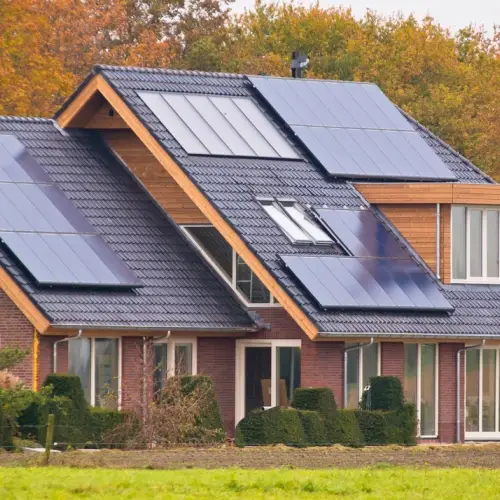
The flat plate solar collector is a type of thermal solar panel whose purpose is to transform solar radiation into thermal energy.
This type of solar thermal panels have a good cost/effectiveness ratio in moderate climates and are well suited to a large number of thermal applications, such as:
- Domestic hot water (DHW) production.
- Swimming pool heating.
- Support for heating through solar thermal energy.
- Preheating of industrial fluids.
Parts of a flat solar collector
The flat solar collector is made up of the following elements:
1. Absorber
The absorber is the element that intercepts solar radiation inside the collector and is responsible for transforming solar energy into thermal energy.
The absorber is usually made of a metal sheet, normally copper (a good thermal conductor) that is darkened. Dark and matte bodies capture solar radiation better than any other colour.
There are two ways to darken the absorber:
-
A thin film of black heat-resistant paint withstands high temperatures.
-
A selective treatment, based on electrochemical depositions or paints with metallic oxides that have a high absorption of solar radiation and a low heat emissivity.
The absorber incorporates a grid of conduits through which the heat transfer fluid will circulate.
2. Transparent cover
The transparent cover has the function of isolating the solar collector from external environmental conditions and allowing solar radiation to pass through. This cover is what causes the greenhouse effect.
It is usually made up of a single sheet of resistant glass approximately 4 mm thick.
This part is only present in glazed flat solar collectors.
3. Isolation
The purpose of insulation is to prevent heat loss from the inside of the collector - specifically the absorber - to the outside. It is normally made up of synthetic foam sheets (polyurethane, cyanide, fibreglass, etc.) located on the sides and back of the solar panel.
4. Housing
The housing is used to house the rest of the components of the solar collector.
This closure is usually made of an aluminium profile that guarantees the resistance of the assembly, even in extreme working conditions. In addition, the casing has condensate drainage holes at the bottom.
How does a flat solar collector work?
 The operation of a flat solar collector is based on heat transfer.
The operation of a flat solar collector is based on heat transfer.
Solar radiation hits the collector's heat absorber. When the radiation hits the surface of the absorber, part of its energy is converted into heat. As a result, the temperature of the solar collector increases.
If a fluid is passed through the collector, part of this heat is transferred to the liquid in accordance with the first and second laws of thermodynamics. The rest of the energy is still lost in the form of radiation from the solar thermal collector to the outside environment.
If we want to obtain good performance and reduce energy consumption, the collectors must be operated at the lowest possible temperature.
Types of flat solar collectors
We can classify flat plate solar collectors in two different ways.
On the one hand, if we classify them based on the configuration of the absorber we have:
-
Parallel absorber configuration : this type of collector can be used in a horizontal or vertical position. The parallel configuration allows temperature stratification in the collector, as the largest volume of water circulates through the internal branches of the collector.
-
Series absorber configuration : it is composed of a single continuous circuit, with a smaller volume of circulating water and a greater thermal jump, which gives it good performance.
On the other hand, we can also distinguish solar collectors according to whether they are glazed or not:
- Glazed : This is mainly used in domestic water heating systems or other heating installations. Its operating temperature ranges from 30°C to 60°C. This collector consists of an insulated box covered by glazing. Inside this box, an absorber transmits heat to the fluid circulating through it. The glazing blocks infrared radiation and insulates the air space above the absorber, thus retaining the heat.
- Unglazed : This type of collector is cheaper, although less common. Depending on the outside temperature, it is generally used in swimming pool heating systems or sometimes as a hot water heating system in warm regions. In temperate areas, the operating temperature is generally below 30°C.
Advantages of glazed solar collectors
This type of collector has a transparent cover that captures the radiation that bounces off the absorber and increases overall efficiency. To achieve this, the transparent cover of the collector generates a greenhouse effect.
The greenhouse effect is generated in some transparent bodies, which are normally only penetrated by radiation with wavelengths between 0.3 and 3 microns. Since most solar radiation is between 0.3 and 2.4 microns, sunlight can pass through glass.
Once through, the radiation encounters the absorber, which is heated by solar radiation and emits radiation between 4.5 and 7.2 microns that cannot pass through the glass again.
This solar radiation that cannot escape is reflected back into the interior. Part of this energy heats the glass and the glass re-emits it inwards and outwards.